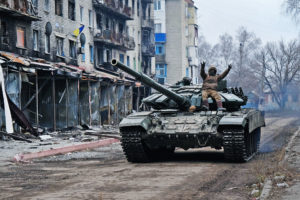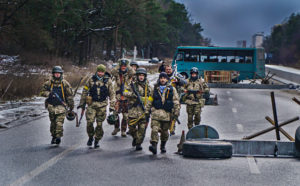In “continental warfare”, each side strives to retain and, if possible, increase its “operational reserve” — the sum total of trained and equipped combat units that are not in combat. It is only with an operational reserve that strategic choices can be made: whether to keep forces ready to counter an expected enemy offensive, or to launch an offensive to drive back the enemy, or, better still, to penetrate the enemy front, roll out and encircle enemy forces. It was by a succession of such offensive “envelopments” that the Red Army drove back the Germans from Stalingrad all the way to Berlin. The Allies did the same on a much smaller scale after the 1944 Normandy landings.
Of course, until an operational reserve is built up and offensives can be launched, frontal forces are absolutely necessary, whether to resist an advancing enemy or to keep attacking the enemy, so that it cannot withdraw its frontal forces to build up its own operational reserve. But frontal forces can only fight by attrition, First World War-style, to kill and wound enemy troops in front of them. And an entire war fought by attrition alone must last for years, killing and maiming troops on both sides until one side or the other gives up because of sheer exhaustion.
That is what happened on November 11, 1918, when Germany surrendered, even though not one Allied soldier had entered German territory, which remained almost undamaged in spite of the British and French air raids that hit a few buildings here and there. It was because Germany was neither devastated nor occupied after its surrender that it could go to war again just 20 years later, with catastrophic consequences. In other words, attrition is not only costly in lives, but it is also inconclusive, for it does not exhaust the will to fight.
Why is this relevant? Ever since the failure of the Russian air assault at the Antonov airfield on the first night of its invasion, which was supposed to open the way for the conquest of Kyiv and the country’s surrender, Ukraine has been fighting a war of attrition. At the cost of mounting casualties, Ukrainian frontal warfare has been successful enough to induce the Russians to withdraw from Kharkiv, the country’s second-largest city, to prevent the seemingly inevitable Russian conquest of Odesa, the country’s premier port, and to limit Russian advances in the most contested Donetsk and Luhansk regions, lately by holding Bakhmut in a house-by-house, street-by-street fight, in spite of relentless attacks by Russia’s Wagner mercenaries.
But the greatest success of Ukraine’s frontal resistance has occurred behind the front, with the gradual build-up of an increasing large, well-trained, and well-armed operational reserve of combat units that could be held back from combat because the frontal forces proved sufficiently strong to stop Russian advances without need of large reinforcements. It means that, for the first time since the start of the war, Ukraine’s war leaders can now take the initiative, instead of just repelling one Russian attack after another in different sectors of the very long front.
They can therefore choose a course of action from within a spectrum of risks and possible gains: from remaining on the defensive overall while launching successive attacks to drive back the Russians in one sector after another, each a limited-risk effort; to the boldest option of concentrating all available forces for a deep-penetration offensive to scythe across the roads and rail lines that sustain Russia’s forces within an entire region. The peculiar geography of the war, dominated by the curve of the great Dnipro river, offers several choices for such a bold move, including the most ambitious: an all-out offensive from Zaporizhzhia all the way to the Black Sea at Berdyans’k, or even at Mariupol, only 40 miles from the Russian border.
Regardless of the chosen sector, unless the Russians have large forces ready to counter-attack powerfully enough to promptly drive back the Ukrainians, the result of an all-out offensive could be a spectacular Russian defeat, complete with an unprecedented number of prisoners. It might even finally provoke challenges to Putin’s direction of the war, and hence his entire leadership.
That Ukraine’s leaders can finally choose between different options is a great advance, even if the chosen option is to hold back the operational reserve until the Russians make a move of their own. This is entirely possible: the assault on Bakhmut that has long dominated the headlines has been intense but also very limited in its scope. The Russians who fought and died in the house-to-house fighting were not the military professionals of the elite forces, nor were they the deployable troops obtained from last year’s call-up of 300,000 reservists, or the units manned by contract soldiers — but rather the Wagner expendables.
This means that there are sufficiently large numbers of uncommitted Russian forces somewhere — perhaps in Belarus, Russia itself or occupied Ukraine — to allow the Kremlin to launch its own offensive. But even that is bound to be inconclusive because only a conquest of Kyiv could be decisive, and that is now an impossibility unless the entire Russian army is mobilised for that purpose.
If there is a Russian offensive, a Ukrainian counter-offensive launched after the Russians have used their operational reserves could yield even greater results, forcing the Kremlin onto the defensive, perhaps even to the point of seeking a ceasefire. If Kyiv and the West are looking for the most plausible path to victory, this is it.
Disclaimer
Some of the posts we share are controversial and we do not necessarily agree with them in the whole extend. Sometimes we agree with the content or part of it but we do not agree with the narration or language. Nevertheless we find them somehow interesting, valuable and/or informative or we share them, because we strongly believe in freedom of speech, free press and journalism. We strongly encourage you to have a critical approach to all the content, do your own research and analysis to build your own opinion.
We would be glad to have your feedback.
Source: UnHerd Read the original article here: https://unherd.com/




